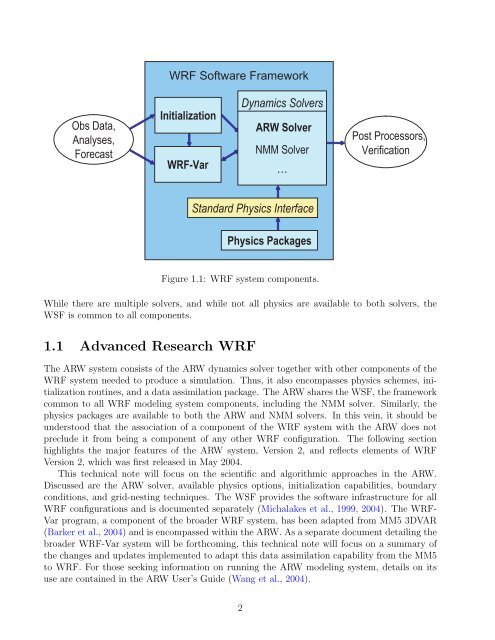Advanced Research WRF (ARW) Technical Note - MMM - University ...
Advanced Research WRF (ARW) Technical Note - MMM - University ...
Advanced Research WRF (ARW) Technical Note - MMM - University ...
You also want an ePaper? Increase the reach of your titles
YUMPU automatically turns print PDFs into web optimized ePapers that Google loves.
Obs Data,<br />
Analyses,<br />
Forecast<br />
<strong>WRF</strong> Software Framework<br />
Initialization<br />
<strong>WRF</strong>-Var<br />
Dynamics Solvers<br />
<strong>ARW</strong> Solver<br />
NMM Solver<br />
…<br />
Standard Physics Interface<br />
Physics Packages<br />
Figure 1.1: <strong>WRF</strong> system components.<br />
Post Processors,<br />
Verification<br />
While there are multiple solvers, and while not all physics are available to both solvers, the<br />
WSF is common to all components.<br />
1.1 <strong>Advanced</strong> <strong>Research</strong> <strong>WRF</strong><br />
The <strong>ARW</strong> system consists of the <strong>ARW</strong> dynamics solver together with other components of the<br />
<strong>WRF</strong> system needed to produce a simulation. Thus, it also encompasses physics schemes, initialization<br />
routines, and a data assimilation package. The <strong>ARW</strong> shares the WSF, the framework<br />
common to all <strong>WRF</strong> modeling system components, including the NMM solver. Similarly, the<br />
physics packages are available to both the <strong>ARW</strong> and NMM solvers. In this vein, it should be<br />
understood that the association of a component of the <strong>WRF</strong> system with the <strong>ARW</strong> does not<br />
preclude it from being a component of any other <strong>WRF</strong> configuration. The following section<br />
highlights the major features of the <strong>ARW</strong> system, Version 2, and reflects elements of <strong>WRF</strong><br />
Version 2, which was first released in May 2004.<br />
This technical note will focus on the scientific and algorithmic approaches in the <strong>ARW</strong>.<br />
Discussed are the <strong>ARW</strong> solver, available physics options, initialization capabilities, boundary<br />
conditions, and grid-nesting techniques. The WSF provides the software infrastructure for all<br />
<strong>WRF</strong> configurations and is documented separately (Michalakes et al., 1999, 2004). The <strong>WRF</strong>-<br />
Var program, a component of the broader <strong>WRF</strong> system, has been adapted from MM5 3DVAR<br />
(Barker et al., 2004) and is encompassed within the <strong>ARW</strong>. As a separate document detailing the<br />
broader <strong>WRF</strong>-Var system will be forthcoming, this technical note will focus on a summary of<br />
the changes and updates implemented to adapt this data assimilation capability from the MM5<br />
to <strong>WRF</strong>. For those seeking information on running the <strong>ARW</strong> modeling system, details on its<br />
use are contained in the <strong>ARW</strong> User’s Guide (Wang et al., 2004).<br />
2
















